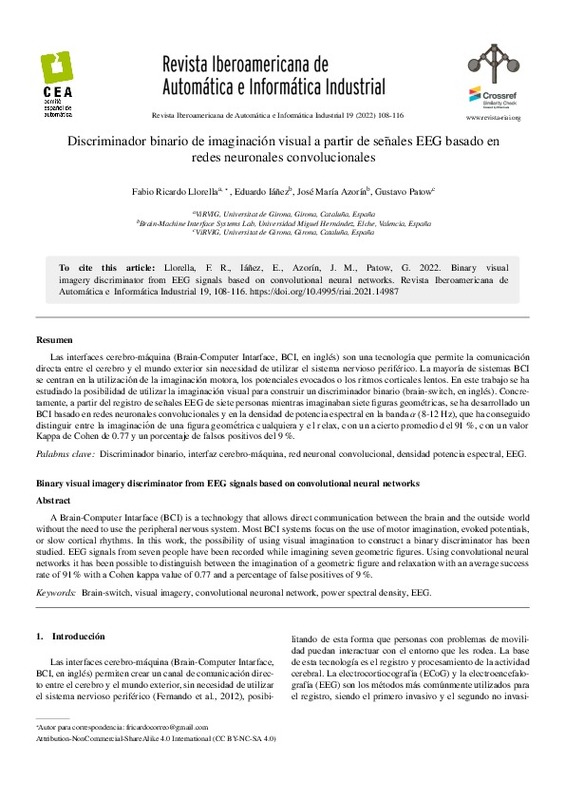Abhiram, Singh, A., Gumaste, 2019. Decoding imagined speech and computer control using brain waves. arXiv.
Aggarwal, S., Chugh, N., Jan. 2019. Signal processing techniques for motor imagery brain computer interface: A review. Array 1-2, 100003. https://doi.org/10.1016/j.array.2019.100003
Ahn, M., Lee, M., Choi, J., Jun, S., Aug. 2014. A review of brain-computer interface games and an opinion survey from researchers, developers and users. Sensors 14 (8), 14601-14633. https://doi.org/10.3390/s140814601
[+]
Abhiram, Singh, A., Gumaste, 2019. Decoding imagined speech and computer control using brain waves. arXiv.
Aggarwal, S., Chugh, N., Jan. 2019. Signal processing techniques for motor imagery brain computer interface: A review. Array 1-2, 100003. https://doi.org/10.1016/j.array.2019.100003
Ahn, M., Lee, M., Choi, J., Jun, S., Aug. 2014. A review of brain-computer interface games and an opinion survey from researchers, developers and users. Sensors 14 (8), 14601-14633. https://doi.org/10.3390/s140814601
Altman, D. G., 2006. Practical Statistics for Medical Research. Chapman & Hall/CRC.
Anderson, C. W., Sijercic, Z., 1996. Classification of eeg signals from four subjects during five mental tasks. In: Solving engineering problems with neural networks: proceedings of the conference on engineering applications in neural networks (EANN'96). Turkey, pp. 407-414.
Bigdely-Shamlo, N., Mullen, T., Kothe, C., Su, K.-M., Robbins, K. A., Jun.2015. The PREP pipeline: standardized preprocessing for large-scale EEG analysis. Frontiers in Neuroinformatics 9. https://doi.org/10.3389/fninf.2015.00016
Birbaumer, N., Ghanayim, N., Hinterberger, T., Iversen, I., Kotchoubey, B., Kubler, A., Perelmouter, J., Taub, E., Flor, H., Mar. 1999. A spelling device for the paralysed. Nature 398 (6725), 297-298. https://doi.org/10.1038/18581
Bobrov, P., Frolov, A., Cantor, C., Fedulova, I., Bakhnyan, M., Zhavoronkov, A., Jun. 2011. Brain-computer interface based on generation of visual images. PLoS ONE 6 (6), e20674. https://doi.org/10.1371/journal.pone.0020674
Craik, A., He, Y., Contreras-Vidal, J. L., Apr. 2019. Deep learning for electroencephalogram (EEG) classification tasks: a review. Journal of Neural Engineering 16 (3), 031001. https://doi.org/10.1088/1741-2552/ab0ab5
Esfahani, E. T., Sundararajan, V., Oct. 2012. Classification of primitive shapes using brain-computer interfaces. Computer-Aided Design 44 (10), 1011-1019. https://doi.org/10.1016/j.cad.2011.04.008
Fernando, L., Nicolas-Alonso, J., Gomez-Gil, 2012. Brain computer interface, a review. Sensors 12 (2), 1211-1279. https://doi.org/10.3390/s120201211
Gavali, P., Banu, J. S., 2019. Deep convolutional neural network for image classification on CUDA platform. In: Deep Learning and Parallel Computing Environment for Bioengineering Systems. Elsevier, pp. 99-122. https://doi.org/10.1016/B978-0-12-816718-2.00013-0
Gong, M., Xu, G., Li, M., Lin, F., May 2020. An idle state-detecting method based on transient visual evoked potentials for an asynchronous ERP-based BCI. Journal of Neuroscience Methods 337, 108670. https://doi.org/10.1016/j.jneumeth.2020.108670
Han, C.-H., Muller, K.-R., Hwang, H.-J., Mar. 2020. Brain-switches for asynchronous brain-computer interfaces: A systematic review. Electronics 9 (3), 422. https://doi.org/10.3390/electronics9030422
Hortal, E., Planelles, D., Resquin, F., Climent, J. M., Azorín, J. M., Pons, J. L., Oct. 2015. Using a brain-machine interface to control a hybrid upper limb exoskeleton during rehabilitation of patients with neurological conditions. Journal of NeuroEngineering and Rehabilitation 12 (1). https://doi.org/10.1186/s12984-015-0082-9
Jiang, J., Zhou, Z., Yin, E., Yu, Y., Liu, Y., Hu, D., Nov. 2015. A novel morse code-inspired method for multiclass motor imagery brain-computer interface (BCI) design. Computers in Biology and Medicine 66, 11-19. https://doi.org/10.1016/j.compbiomed.2015.08.011
Jurcak, V., Tsuzuki, D., Dan, I., Feb. 2007. 10/20, 10/10, and 10/5 systems revisited: Their validity as relative head-surface-based positioning systems. NeuroImage 34 (4), 1600-1611. https://doi.org/10.1016/j.neuroimage.2006.09.024
Kim, C., Sun, J., Liu, D., Wang, Q., Paek, S., Mar. 2018. An effective feature extraction method by power spectral density of EEG signal for 2-class motor imagery-based BCI. Medical & Biological Engineering & Computing 56 (9), 1645-1658. https://doi.org/10.1007/s11517-017-1761-4
Knauff, M., Kassubek, J., Mulack, T., Greenlee, M. W., Dec. 2000. Cortical activation evoked by visual mental imagery as measured by fMRI. NeuroReport 11 (18), 3957-3962. https://doi.org/10.1097/00001756-200012180-00011
Kosmyna, N., Lindgren, J. T., Lecuyer, A., Sep. 2018. Attending to visual stimuli versus performing visual imagery as a control strategy for EEG-based brain-computer interfaces. Scientific Reports 8 (1). https://doi.org/10.1038/s41598-018-31472-9
Lotte, F., Congedo, M., Lecuyer, A., Lamarche, F., Arnaldi, B., Jan. 2007. A review of classification algorithms for EEG-based brain-computer interfaces. Journal of Neural Engineering 4 (2), R1-R13. https://doi.org/10.1088/1741-2560/4/2/R01
McCall, J., Dec. 2005. Genetic algorithms for modelling and optimisation. Journal of Computational and Applied Mathematics 184 (1), 205-222. https://doi.org/10.1016/j.cam.2004.07.034
Melnik, A., Legkov, P., Izdebski, K., Karcher, S. M., Hairston, W. D., Ferris, D. P., Konig, P., Mar. 2017. Systems, subjects, sessions: To what extent do these factors influence EEG data? Frontiers in Human Neuroscience 11. https://doi.org/10.3389/fnhum.2017.00150
Pedroni, A., Bahreini, A., Langer, N., Nov. 2019. Automagic: Standardized preprocessing of big EEG data. bioRxiv. https://doi.org/10.1101/460469
Planelles, D., Hortal, E., Costa, Á., Úbeda, A., Iáez, E., Azorín, J., Sep. 2014. Evaluating classifiers to detect arm movement intention from EEG signals. Sensors 14 (10), 18172-18186. https://doi.org/10.3390/s141018172
Proakis, John, M., Dimitri, 1996. Digital signal processing: principles, algorithms and applications. Prentice-Hall, 910-913.
Reza, Abiri, S., Borhani, E. W., Sellers, Y., Jiang, X., Zhao, 2018. A comprehensive review of eeg-based brain-computer interface paradigms. Journal of Neural Engineering 16. https://doi.org/10.1088/1741-2552/aaf12e
Seeck, M., Koessler, L., Bast, T., Leijten, F., Michel, C., Baumgartner, C., He, B., Beniczky, S., Oct. 2017. The standardized EEG electrode array of the IFCN. Clinical Neurophysiology 128 (10), 2070-2077. https://doi.org/10.1016/j.clinph.2017.06.254
Swets, J., 2014. Signal detection theory and ROC analysis in psychology and diagnostics : collected papers. Psychology Press, New York, New York Hove, England. https://doi.org/10.4324/9781315806167
Xie, S., Kaiser, D., Cichy, R. M., Aug. 2020. Visual imagery and perception share neural representations in the alpha frequency band. Current Biology 30 (15), 3062. https://doi.org/10.1016/j.cub.2020.07.023
Zhang, W., Tan, C., Sun, F., Wu, H., Zhang, B., Dec. 2018. A review of EEGbased brain-computer interface systems design. Brain Science Advances 4 (2), 156-167. https://doi.org/10.26599/BSA.2018.9050010
[-]









